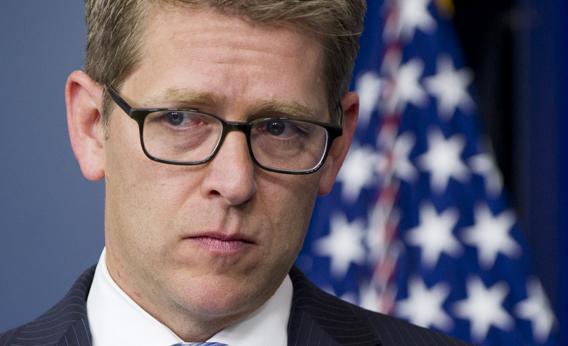Last week President Obama announced restrictions on U.S. drone strikes. He touted the rules—“written policy standards and procedures that formalize and strengthen the Administration’s rigorous process” for authorizing targeted killings—in a policy statement, a speech, and a background briefing by senior administration officials.
This week Obama went right back to business. He killed a Taliban leader with a drone strike in Pakistan, and White House press secretary Jay Carney won’t even admit that’s what happened. The strike, coupled with the administration’s evasive answers about it, exposes the loopholes in the toothless new policy. Here’s a list of them:
1. Transparency. In his speech, Obama pledged a new “transparency” about the drone program. He framed his policy statement as a commitment to “share” information with the public so citizens can “make informed judgments and hold the Executive Branch accountable.” But on Wednesday, when reporters asked about the reported strike on Taliban leader Wali ur-Rehman, Carney refused to confirm it. The transparency pledge, Carney explained, applies only to the administration’s “standards” for authorizing strikes, not to “the details of every counterterrorism operation.” That’s like reciting your marital vows when your spouse asks where you were last night.
2. Associated forces. “Beyond the Afghan theater, we only target al-Qaida and its associated forces,” Obama declared in his speech. The appended clause—and associated forces—covers Rehman, other Taliban operatives, and God knows who else. We don’t believe in guilt by association. But we do believe in execution by association.
3. Punishment. “Lethal force will not be proposed or pursued as punishment,” says the policy statement. However, targeting decisions “will be informed by a broad analysis of an intended target’s current and past role in plots threatening U.S. persons.” That’s not much of a distinction. When reporters asked about the strike in Pakistan, Carney noted that Rehman was “wanted in connection to the murder of seven American citizens on Dec. 30, 2009, at Forward Operating Base Chapman in Khost, Afghanistan.” We’ll kill you for what you did to us. We just won’t call it punishment.
4. Feasible capture. This is an old loophole, but the policy statement broadens it. “The policy of the United States is not to use lethal force when it is feasible to capture a terrorist suspect,” says the statement. Then comes the big caveat: “Capture operations are conducted only against suspects who may lawfully be captured or otherwise taken into custody by the United States and only when the operation can be conducted in accordance with all applicable law and consistent with our obligations to other sovereign states.” Even when we have the physical ability to capture you, doing so might violate domestic or international law. In that case we’ll have to kill you instead.
5. Preference. The policy statement asserts a “Preference for Capture.” Obama, in his speech, reaffirmed that “our preference is always to detain, interrogate, and prosecute.” In the background briefing, administration officials assured reporters that the U.S. has a “preference” to administer strikes through the military rather than the CIA, as well as a “preference for working with partners and strengthening their capacity to take action against terrorist networks.” To illustrate this point, the officials cited the administration’s collaborative approach “in Pakistan, where the Pakistanis have taken action against extremists.” So what did we do when we found Rehman, knowing that Pakistani security forces wanted to kill him? Did we hand off the job to them? No, we did it ourselves. Deferring to local governments is just a “preference.”
6. War theater. All the principles outlined in the policy statement and the speech—imminent threat, feasible capture, external oversight, avoiding civilian casualties—are reserved for strikes “outside areas of active hostilities.” So when reporters asked about Rehman, Carney explained that in “the Afghan war theater … we will continue to take strikes against high-value al-Qaida targets but also against forces that are massing to support attacks on coalition forces.” Never mind that the Rehman strike was in Pakistan: That, too, is part of the Afghan “theater.” But don’t worry: Obama pledged in his speech that “by the end of 2014, we will no longer have the same need for force protection, and the progress we’ve made against core al-Qaida will reduce the need for unmanned strikes.” We’ll still use drones there. We’ll just point out that we’re doing it less.
7. Demilitarized CIA. In the background briefing, administration officials said the new policy acknowledges “that the United States military is the appropriate agency to use force outside of active warzones, given their traditional role and given the transparency [that] can be associated with actions by the United States military.” So in places where we aren’t at war, we’ll administer drone strikes through our war department. And in places where we are at war, we’ll administer drone strikes through our intelligence agency. The policy is absurd, but it allows the administration to pretend that we didn’t kill Rehman, since that would be disclosure of an intelligence operation.
8. “Reservation of Authority.” That’s the all-purpose exception Obama inserted at the end of his policy statement. It says the rules outlined in the statement “do not limit the President’s authority to take action in extraordinary circumstances when doing so is both lawful and necessary to protect the United States or its allies.” That last bit—or its allies—makes the rules open to suspension, at the president’s choosing, anywhere in the world. Obama and his lawyers have gotten exactly what they wanted: the appearance of constraint, without the reality.
William Saletan’s latest short takes on the news, via Twitter:
